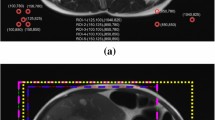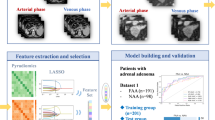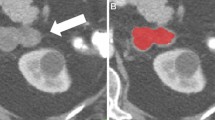Abstract
Objectives
To develop a fully automated deep learning model for adrenal segmentation and to evaluate its performance in classifying adrenal hyperplasia.
Methods
This retrospective study evaluated automated adrenal segmentation in 308 abdominal CT scans from 48 patients with adrenal hyperplasia and 260 patients with normal glands from 2010 to 2021 (mean age, 42 years; 156 women). The dataset was split into training, validation, and test sets at a ratio of 6:2:2. Contrast-enhanced CT images and manually drawn adrenal gland masks were used to develop a U-Net-based segmentation model. Predicted adrenal volumes were obtained by fivefold splitting of the dataset without overlapping the test set. Adrenal volumes and anthropometric parameters (height, weight, and sex) were utilized to develop an algorithm to classify adrenal hyperplasia, using multilayer perceptron, support vector classification, a random forest classifier, and a decision tree classifier. To measure the performance of the developed model, the dice coefficient and intraclass correlation coefficient (ICC) were used for segmentation, and area under the receiver operating characteristic curve (AUC), accuracy, sensitivity, and specificity were used for classification.
Results
The model for segmenting adrenal glands achieved a Dice coefficient of 0.7009 for 308 cases and an ICC of 0.91 (95% CI, 0.90–0.93) for adrenal volume. The models for classifying hyperplasia had the following results: AUC, 0.98–0.99; accuracy, 0.948–0.961; sensitivity, 0.750–0.813; and specificity, 0.973–1.000.
Conclusion
The proposed segmentation algorithm can accurately segment the adrenal glands on CT scans and may help clinicians identify possible cases of adrenal hyperplasia.
Key Points
• A deep learning segmentation method can accurately segment the adrenal gland, which is a small organ, on CT scans.
• The machine learning algorithm to classify adrenal hyperplasia using adrenal volume and anthropometric parameters (height, weight, and sex) showed good performance.
• The proposed segmentation algorithm may help clinicians identify possible cases of adrenal hyperplasia.





Similar content being viewed by others
Abbreviations
- DL:
-
Deep learning
- DT:
-
Decision tree classifier
- ICC:
-
Intraclass correlation coefficient
- MLP:
-
Multilayer perceptron
- RF:
-
Random forest classifier
- SVC:
-
Support vector classification
References
Salamat MS (2010) Robbins and Cotran: pathologic basis of disease, 8th Edition. J Neuropathol Exp Neurol 69:214. https://doi.org/10.1097/NEN.0b013e3181cd8dbc
Turcu AF, Mallappa A, Elman MS et al (2017) 11-Oxygenated androgens are biomarkers of adrenal volume and testicular adrenal rest tumors in 21-hydroxylase deficiency. J Clin Endocrinol Metab 102:2701–2710. https://doi.org/10.1210/jc.2016-3989
Godoy-Matos AF, Vieira AR, Moreira RO et al (2006) The potential role of increased adrenal volume in the pathophysiology of obesity-related type 2 diabetes. J Endocrinol Invest 29:159–163. https://doi.org/10.1007/BF03344090
Reisch N, Scherr M, Flade L et al (2010) Total adrenal volume but not testicular adrenal rest tumor volume is associated with hormonal control in patients with 21-hydroxylase deficiency. J Clin Endocrinol Metab 95:2065–2072. https://doi.org/10.1210/jc.2009-1929
Chrysostomou P, Lodish M, Turkbey E et al (2016) Use of 3-dimensional volumetric modeling of adrenal gland size in patients with primary pigmented nodular adrenocortical disease. Horm Metab Res 48:242–246. https://doi.org/10.1055/s-0042-103686
Degenhart C, Schneller J, Osswald A et al (2017) Volumetric and densitometric evaluation of the adrenal glands in patients with primary aldosteronism. Clin Endocrinol 86:325–331. https://doi.org/10.1111/cen.13258
Velema MS, Canu L, Dekkers T et al (2021) Volumetric evaluation of CT images of adrenal glands in primary aldosteronism. J Endocrinol Invest 44:2359–2366. https://doi.org/10.1007/s40618-021-01540-5
Wurth R, Tirosh A, Kamilaris CDC et al (2021) Volumetric modeling of adrenal gland size in primary bilateral macronodular adrenocortical hyperplasia. J Endocr Soc 5:bvaa162. https://doi.org/10.1210/jendso/bvaa162
Tang YZ, Bharwani N, Micco M et al (2014) The prevalence of incidentally detected adrenal enlargement on CT. Clin Radiol 69:e37–e42. https://doi.org/10.1016/j.crad.2013.08.017
Li L, Gu W, Dou J et al (2015) Incidental adrenal enlargement: an overview from a retrospective study in a Chinese population. Int J Endocrinol 2015:192874. https://doi.org/10.1155/2015/192874
Morani AC, Jensen CT, Habra MA et al (2020) Adrenocortical hyperplasia: a review of clinical presentation and imaging. Abdom Radiol (NY) 45:917–927. https://doi.org/10.1007/s00261-019-02048-6
Gibson E, Giganti F, Hu Y et al (2018) Automatic multi-organ segmentation on abdominal CT with dense V-networks. IEEE Trans Med Imaging 37:1822–1834. https://doi.org/10.1109/TMI.2018.2806309
Luo G, Yang Q, Chen T et al (2021) An optimized two-stage cascaded deep neural network for adrenal segmentation on CT images. Comput Biol Med 136:104749. https://doi.org/10.1016/j.compbiomed.2021.104749
Zhang G, Li Z (2019) An adrenal segmentation model based on shape associating level set in sequence of CT images. J Signal Process Syst 91:1169–1177. https://doi.org/10.1007/s11265-018-1433-0
Kim TM, Kim JH, Jang HN, Choi MH, Cho JY, Kim SY (2022) Adrenalmorphology as an indicator of long-term disease control in adults with classic 21-hydroxylase deficiency. Endocrinol Metab (Seoul) 37:124–137
Vincent JM, Morrison ID, Armstrong P, Reznek RH (1994) The size of normal adrenal glands on computed tomography. Clin Radiol 49:453–455. https://doi.org/10.1016/s0009-9260(05)81739-8
Park SY, Park BK, Park JJ, Kim CK (2016) Differentiation of adrenal hyperplasia from adenoma by use of CT densitometry and percentage washout. AJR Am J Roentgenol 206:106–112. https://doi.org/10.2214/AJR.15.14558
McCormick M, Liu X, Ibanez L et al (2014) ITK: enabling reproducible research and open science. Front Neuroinformatics 8:13. https://doi.org/10.3389/fninf.2014.00013
Ronneberger O, Fischer P, Brox T (2015) U-Net: convolutional networks for biomedical image segmentation. Available via http://arxiv.org/abs/1505.04597
Abraham N, Khan NM (2018) A Novel Focal Tversky loss function with improved attention U-Net for lesion segmentation. Available via http://arxiv.org/abs/1810.07842
Virtanen P, Gommers R, Oliphant TE et al (2020) SciPy 1.0: fundamental algorithms for scientific computing in Python. Nat Methods 17:261–272. https://doi.org/10.1038/s41592-019-0686-2
Pedregosa F, Varoquaux G, Gramfort A et al (2011) Scikit-learn: machine learning in Python. J Mach Learn Res 12:2825–2830
Geraghty EM, Boone JM, McGahan JP, Jain K (2004) Normal organ volume assessment from abdominal CT. Abdom Imaging 29. https://doi.org/10.1007/s00261-003-0139-2
Kim H, Jung J, Kim J et al (2020) Abdominal multi-organ auto-segmentation using 3D-patch-based deep convolutional neural network. Sci Rep 10:6204. https://doi.org/10.1038/s41598-020-63285-0
Humpire-Mamani GE, Bukala J, Scholten ET et al (2020) Fully automatic volume measurement of the spleen at CT using deep learning. Radiol Artif Intell 2:e190102. https://doi.org/10.1148/ryai.2020190102
Lingam RK, Sohaib SA, Vlahos I et al (2003) CT of primary hyperaldosteronism (Conn’s syndrome): the value of measuring the adrenal gland. AJR Am J Roentgenol 181:843–849. https://doi.org/10.2214/ajr.181.3.1810843
Lee SH, Kim JW, Yoon H-K et al (2021) Diagnostic accuracy of computed tomography in predicting primary aldosteronism subtype according to age. Endocrinol Metab 36:401–412. https://doi.org/10.3803/EnM.2020.901
Schneller J, Reiser M, Beuschlein F et al (2014) Linear and volumetric evaluation of the adrenal gland—MDCT-based measurements of the adrenals. Acad Radiol 21:1465–1474. https://doi.org/10.1016/j.acra.2014.06.008
Wang X, Jin Z-Y, Xue H-D et al (2013) Evaluation of normal adrenal gland volume by 64-slice CT. Chin Med Sci J Chung-Kuo Hsueh Ko Hsueh Tsa Chih 27:220–224. https://doi.org/10.1016/s1001-9294(13)60005-x
Funding
This work was supported by the National Research Foundation of Korea (NRF) grant funded by the Korea government (MSIT) (No. NRF-2022R1F1A107351511)
Author information
Authors and Affiliations
Corresponding authors
Ethics declarations
Guarantor
The scientific guarantors of this publication are Sang Youn Kim and Young-gon Kim.
Conflict of interest
The authors of this manuscript declare no relationships with any companies whose products or services may be related to the subject matter of the article.
Statistics and biometry
No complex statistical methods were necessary for this paper.
Informed consent
Written informed consent was waived by the Institutional Review Board.
Ethical approval
This study was approved by the Institutional Review Board of Seoul National University Hospital (IRB no. 2206-175-1336).
Study subjects or cohorts overlap
Some study subjects have been previously reported in a prior study comparing adrenal volume between the normal population and patients with classical 21-hydroxylase deficiency (Endocrinology and Metabolism 2022;37(1):124-137). We only used adrenal volume information in the prior study. However, we used the masks of adrenal glands to develop deep learning based automatic segmentation model in this study.
Methodology
• retrospective
• diagnostic study
• performed at one institution
Additional information
Publisher’s note
Springer Nature remains neutral with regard to jurisdictional claims in published maps and institutional affiliations.
Rights and permissions
Springer Nature or its licensor (e.g. a society or other partner) holds exclusive rights to this article under a publishing agreement with the author(s) or other rightsholder(s); author self-archiving of the accepted manuscript version of this article is solely governed by the terms of such publishing agreement and applicable law.
About this article
Cite this article
Kim, T.M., Choi, S.J., Ko, J.Y. et al. Fully automatic volume measurement of the adrenal gland on CT using deep learning to classify adrenal hyperplasia. Eur Radiol 33, 4292–4302 (2023). https://doi.org/10.1007/s00330-022-09347-5
Received:
Revised:
Accepted:
Published:
Issue Date:
DOI: https://doi.org/10.1007/s00330-022-09347-5




